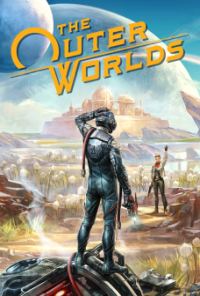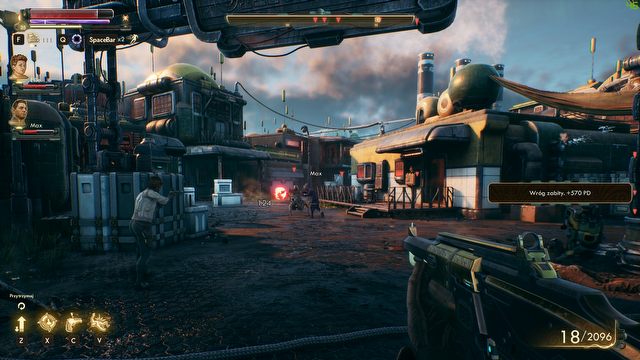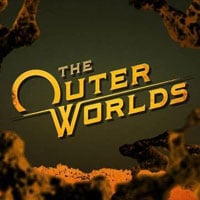The Outer Worlds Review – RPG of the Year? Yeah, of 2012
A year ago, Obsidian heralded The Outer Worlds on the wave of severe criticism of Fallout 76. Today, when Bethesda no longer provides the blanket of a terrible RPG release, things aren't so pretty anymore.
The review is based on the PC version.

- the spirit of classic Fallouts (and New Vegas) is strong in The Outer Worlds;
- a characteristic, colorful universe with a pronounced artistic definition;
- open plot – every NPC can die, and the player can choose their own path;
- the story and dialogs really branch out – lots of ways to solve problems;
- an extensive system of character development, a decent imitation of the SPECIAL;
- crude combat mechanics, further spoiled by poor AI of opponents;
- technologically outdated, poorly optimized, and glitchy;
- tasks and characters could be more interesting (especially the companions);
- the serious story isn't very compatible with the goofy world.
From the beginning, a hushed voice in the back of my head warned me against The Outer Worlds. It tried to convince me that the game is not exactly what I was waiting for – that it will not be another magnum opus from Obsidian Entertainment, worth any amount of money and any number of hours of your life. The silent voice was not quite right... but it wasn't entirely wrong either. The Outer Worlds turned out merely a decent game.
But this project had every chance in the world to be a complete success. After all, Feargus Urquhart's team took the same framework as with their previous games, with Pillars of Eternity at the forefront. They reached to the roots of the RPG genre – in this case, the origins of the Fallout series – and tried serving the same dish, according to the same recipe, maybe adding some more modern flavors, such as original vision and using more modern hardware. The helm was taken by the best people imaginable – Timothy Cain and Leonard Boyarsky, without whom, the Vault Boy would never have been conceived.
Obsidian dropped the isometric perspective (his recent experiments proved that a boom for games with such perspective had ended) and switched to a 3-dimensional environment. And that wasn't the first time he'd done this – Fallout: New Vegas is still widely respected by the fans of the RPG genre, many of whom consider it the best part of the entire series. What could go so wrong in the case of The Outer Worlds? Unfortunately, plenty of things – even in the areas that should not pose a problem to equally experienced developers.
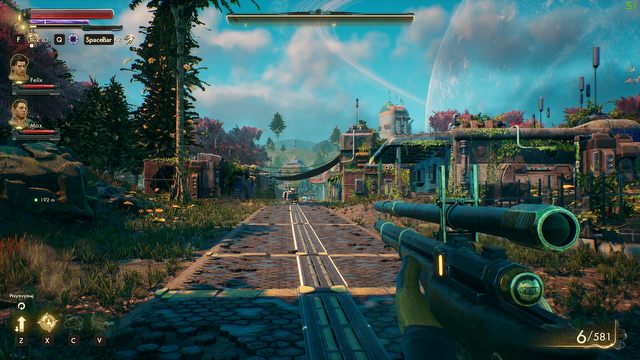
There's an undeniable character to the locations, but are they pretty? Guess it's a matter of personal taste.
Waiter! There's Borerlands in my Fallout!
You'd expect, perhaps, that my critique of The Outer Worlds would revolve largely around the game's archaic technology. That's correct, and I have a lot to say about it, but I'll start with a less obvious, and at the same time more important aspect of the game. I'll start with the setting.
Don't get me wrong – Obsidian created a unique and interesting universe. The wild frontier of the cosmos, ironically named the Arcadia, ruled by an unstable, retrofuturistic corporation, is definitely an interesting place for an adventure. Especially since the creators let their imagination go wild and threw in a lot of crazy ideas, finishing it up with some absurd humor.
Unfortunately, someone decided that this frivolous world will contain a very serious story, with serious moral dilemmas. Sounds a bit like Fallout? Sure, this was undoubtedly the intention of the developers – but they've seemingly taken it too far; we'd ordered black tea, and got Regent's Punch instead. The concoction causes a serious cognitive dissonance.
The world of Fallout was uniquely heavy, gloomy, and no amount of black humor in the game could change that – quite the contrary, actually – it mostly amplified the bleak reality of the post-apocalyptic USA. The general outline of the plot of The Outer Worlds – the struggle for survival of a colony faced with starvation – echoes some familiar themes. The problem is that the game is definitely overloaded with jokes, as for such a serious story.
Humor almost pours from the screen. The power of the corporation is absurd. At every turn, we are confronted with preposterous rules and procedures, and the colonists, almost every single one of them, are a bunch of helpless bureaucrats and utter idiots, who lay their banal problems on the protagonist. Want examples? Just take a look at the screenshots in the text. Maybe it's amusing – but then how is the player supposed to treat the story seriously? And Obsidian ultimately want their work to be taken seriously, because this carousel of joy sometimes unexpectedly freezes, and we're faced with a totally serious choice, such as whether to sacrifice human life in the name of progress.
Playing The Outer Worlds feels like reading The Hitchhiker's Guide to the Galaxy, but with excerpts from Dune, The Foundation, or Solaris popping up every few pages. Or, using a more gaming analogy, it feels like playing Borderlands, and then unexpectedly jumping into the most serious themes of Mass Effect, or perhaps even the horror of Dead Space every now and then. The dissonance is hella strong.
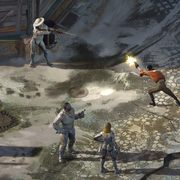
LEFT HOOK FROM ESTONIA
The Outer Worlds is also being robbed from some fame by the release of another RPG. Just ten days before Obsidian's game was released, we've also had the premiere of Disco Elysium. The brings a visionary new approach to isometric RPGs; it's bold, it's unreleting, it's original. It's full of intriguing, sometimes unsettling concepts, and, at the same time, it's realized with fantastic scope, art, and attention to detail – all that from an obscure studio from Estonia! Against the backdrop of such a release, and as a representative of the same genre, the archaic and imitative The Outer Worlds looks even worse.
New Vegas 1.1
Let's see how The Outer Worlds plays. In terms of gameplay, Obsidian Entertainment's latest creation bares the teeth. It's a pure-blood RPG with a gameplay model in which inspirations of Fallout are manifested much more clearly than in the setting. The character development is deep and complex, there's great liberty in playing the role you want, the quests are open and inventive, as is the story itself – those are the foundations of the game, and they do deliver a good deal of fun.
The latter of these made the greatest impression on me in The Outer Worlds. The adventure begins once the hero created by the player, a member of the thousands-strong crew of the lost colonization ship Hope, is awakened from hibernation by the "mad scientist," Phineas Wells. He presents a rather bleak situation to the protagonist – the Council, a body governing the corporation, is leading the Arcadia to its demise, having turned the promising foothold of humanity into an undernourished hell plagued with red tape.
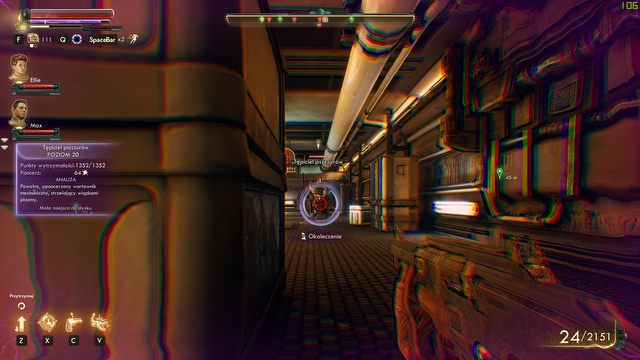
There's also the equivalent of the V.A.T.S. - it's more of a bullet time here, but the principle is largely the same.
The only way to salvation, explains Welles, is to awaken the greatest minds of Hope, and overthrow the Council with their help. At this point, you may think that the framework of the story has just been established, and the good and bad characters introduced. But the game quickly suggest a subversive thought: why not team up with the corporation, and give them the outlaw scientist? After all, the Council is probably also aware of how dire things look in the colony, and it should have a solution to that. And why not just ignore the entire affair and just try to use your position to fill in your own pockets? Or just drown the Arcadia in blood, killing everyone on your way?
The game isn't a straight sandbox, but the story of The Outer Worlds has some very strong sandbox (or rather: nonlinear) features. And even though we only have two basic endings (achieved through a series of quests that are largely the same missions), the players can achieve much different results depending on they way they decide to complete the missions, treat certain characters, and deal with different factions. The players that enjoy exchanging their stories with others will love it.
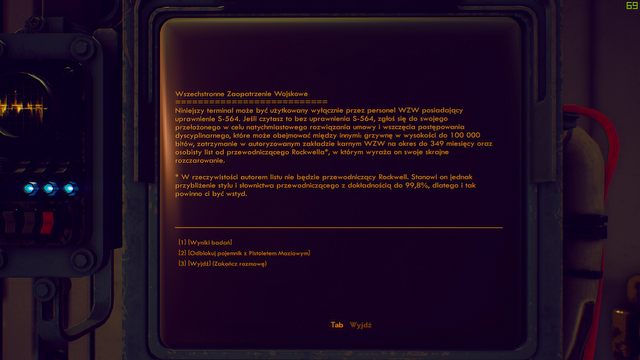
If you still have doubts concerning how similar the game is to FNV, check out the interface on the computers.
THE END CROWNS THE WORK
We mentioned this in a recent review of GreedFall, so it wouldn't hurt to provide similar information here. The Outer Worlds is similarly a game, in which completing the final quest means finishing the entire game. After a certain point, it is no longer possible to return to the unfinished tasks, and after seeing the credits, we land in the main menu. (The arrival of that moment is of course signalled by the game).
Do what you have to do
Thus, we come to the second strongest aspect of the game, i.e. the freedom of solving problems. Obsidian doesn't even try to hide that the foundation of the mechanics in The Outer Worlds – and especially the character development – is derived directly from Fallout's SPECIAL. At the core are six attributes that determine more than a dozen skills, and the aptitudes further modify the stats (they're an equivalent of the famous perks, but since there are only positive aptitudes, the system isn't that compelling).
Still, this gives the player a huge liberty in solving problems during the quests. In addition to formulaic combat talents – melee weapons, shooting, or blocking – you can invest points in lying, hacking, intimidation, or sciences. And, what's even more interesting, we constantly come across the possibility of combining and using all these abilities. That's because there's almost invariably more than one way leading to any location, and before fighting hostile NPCs, the player's are always able to try and solve the dangerous situation with diplomacy. Suffice it to say that the battle with the final boss (and the entire combat sequence preceding it) can be avoided through the use of combined scientific and rhetorical abilities.
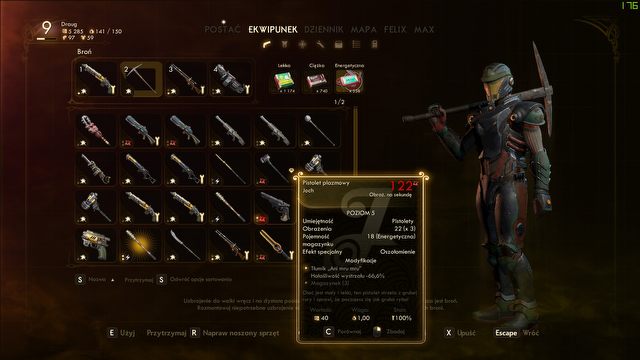
The arsenal of weapons is pretty impressive. However, their availability is messed up, and obtaining really powerful weapons isn't very satisfying.
The freedom to play a character in terms of the mechanics goes hand in hand with how conversations work. This is another element that will make fans of Fallout feel at home. Conversations with NPCs are lushly branching out, giving the player a broad spectrum of possible actions. Just as you can kill any NPC, you can also just insult anyone you're talking to, make cruel fun of them, and steal their last money. In a word – acting like a complete asshole. And another interesting fact here – having a character with very low intelligence opens a special, "children's" version of the dialogue. Not a very practical thing, but it's a nice addition.
The paradox of the third dimension
Up to this point, The Outer Worlds seems able to stand its ground as a very competent RPG, in which the greatest problem is the gimmicky world. Unfortunately, Obsidian made another strategic error when designing the game – they bet on three-dimensional graphics.
Despite numerous conflict avoidance options for nerds and diplomats, TOW still puts a lot of emphasis on fighting. This becomes apparent just seconds after you leave the safety of the city walls. The exploration of the not-so-big portions of the wilderness – even if done along the major routes – is constantly "diversified" by random encounters with groups of enemies, whose sole purpose of existence seems to be waiting for a chance to kill someone. And that wouldn't be anything particularly bad if the combat wasn't as bland.
Nine years have passed since the release of Fallout: New Vegas, and the combat mechanics of The Outer Worlds seem like the game was released no more than a year later. The clumsy animations, dumb AI-controlled enemies, and crude weapon mechanics, which don't let you feel any force of the guns, make the entire experience largely similar to FNV, and rarely offer any satisfaction. And if you think melee weapons offer something better, think again – it’s even worse here. You could try and opt for a stealthy approach and avoid combat altogether (here, Obsidian tried to offer something up-to-date and introduced hiding in tall grass), but this isn't really fun either... Besides, sparing enemies doesn't yield XP, so there's no reward here.
Technical level – Obsidian
The retrograde technical layer is apparent right from the start. Take cities and buildings, for instance – in most cases, these locations are loaded separately, but they're not even substantial in size. Things are particularly bad in the cities, haunted by empty spaces and pitiful imitations of a living environment in form of small groups if motionless dummies (character animations is another matter – equally depressing). There's not even enough background noise to give the impression of being in an actual city. The already mentioned wild areas also look archaic – they're trying to come across as open spaces without even being really open.
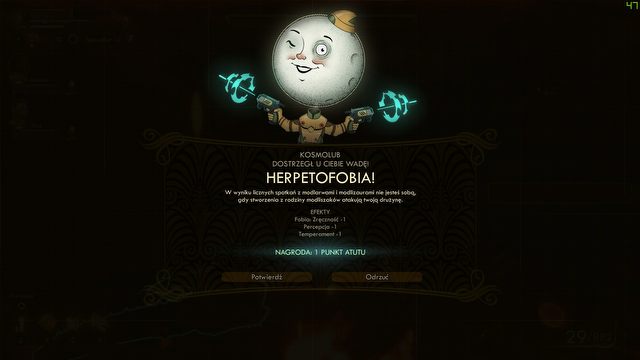
Another original idea in The Outer Worlds are the mechanics of phobia - if we accept certain debuffs in some situations, we'll get new perks in exchange. A nice, albeit mostly cosmetic addition.
If the above description of the "technical wonders" featured in The Outer Worlds wasn't quality entertainment for you, let me talk about optimization for a while. Sorry – "optimization." I played on a decent computer with a Core i5-4570 (3.2 GHz), 16GB of RAM, and a GeForce GTX 1060 (6GB) at very high settings in 1080p resolution, and a stable 60 frames per second was not something I could enjoy often. The framerate often dipped to around 40fps for no apparent reason. As if that wasn't enough – even on an SSD – I often experienced short freezes generated by loading of data, and after getting to a new, larger area, the textures and objects would pop-up right before my eyes for a few seconds. It was grotesque.
On the other hand – during at least 30 hours of play, rarely encountered any major errors. The game of course comes with a fair amount of glitches (such as bodies flying around), but a serious mistake occurred only once: At one point, the game concluded that one of my comrades had died – a few seconds after talking to him, during a completely safe spaceship flight. But that was probably a matter of bad luck. After all, we're talking about a game from Obsidian Entertainment.
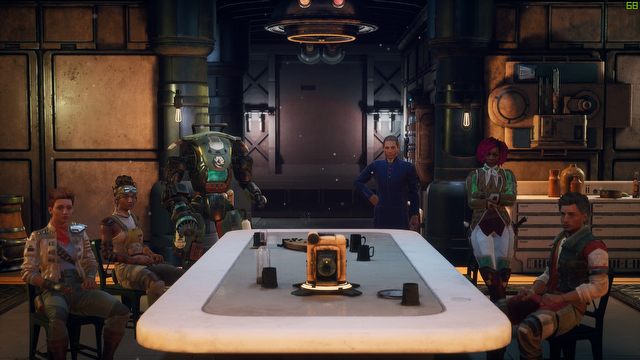
Mass Effect anyone? Unfortunately, the ship and the crew can't really compare not only with Normandy, but even with Andromeda's Tempest. There's just not much life to it.
HAS ANYONE ORDERED A SEQUEL?
We live in a society, where the premiere of a new brand is immediately accompanied by the menace of potential sequels. That's also the case with The Outer Worlds. A spokesman for Microsoft, which, until recently, owned Obsidian Entertainment, said he'd like the game to be the beginning of a new series – a series that could be a standout exclusive title for the Redmond-based corporation. Chances of a sequel are further increased after watching the finale of The Outer Worlds. Admittedly, it ties up almost all the loose ends of the plot, and gives a summary of the fate of each character of the story, but at the same time, leaves enough room for a potential sequel.
Maybe it just doesn't matter?
"If Fallout: New Vegas was a success despite all its technological shortcomings, why should it be different with The Outer Worlds?" There are two factors at play here. First, FNV isn't remembered as an outdated glitchfest only because it gave us a fantastic narrative. TOW doesn't achieve the same quality of the story – and it's not just about the bitter-sweet, incoherent setting.
The game of course has it's share of interesting adventures and inventive tasks, but ultimately, it could have been a lot better. The best way to illustrate this is with the team. It's a bunch of nice personalities, whose dialogues were written with enough skill as to make them feel alive. One would, however, expect more charm from them – especially from their personal threads, often very short, seeming rather forced. Same goes for many quests, even the main ones – a lot of them feels purposeless.
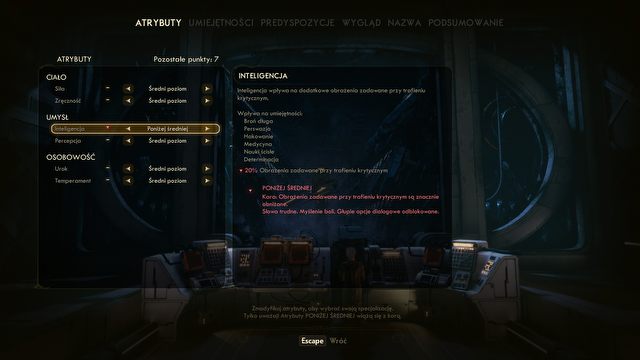
The character creator is quite interesting. The appearance and stats of the protagonist are actually the features, according to which Phineas Welles finds the right candidate to be awoken. Nice.
The other big problem of The Outer Worlds is that a lot has happened in the RPG genre since the release of Fallout: New Vegas. We've witnessed a major convergence of the Action and RPG genres; self-identifying as role-play is no longer an excuse for crude combat mechanics. If we consider FPP games, there's not just the upcoming Cyberpunk 2077, but even the poor Fallout 4, falling short of most real shooters, is miles ahead TOW in terms of gunplay.
All this leads to the sad conclusion that Obsidian Entertainment just did not have enough money to make The Outer Worlds the kind of game they'd wanted. I suspect that the lion's share of the budget went to recording dialogues (with a moderately successful result) and the work of the designers who had to give Arcadia a unique feel (this, for a change, turned out quite well). Using the Unreal Engine was likely a move aimed at saving some cash – this, theoretically, ensured nice graphics at a small price – further reduced with the deal with Epic Games Store.
Unfortunately, the developers didn't have the means to polish the mechanics, make the world a bit bigger, and, especially, allow more imagination in telling the story – making it longer, with more cut-scenes and twists. Suffice it to say that the conclusion of the main plot can safely be reached in just 15 hours (side quests should yield another 15).
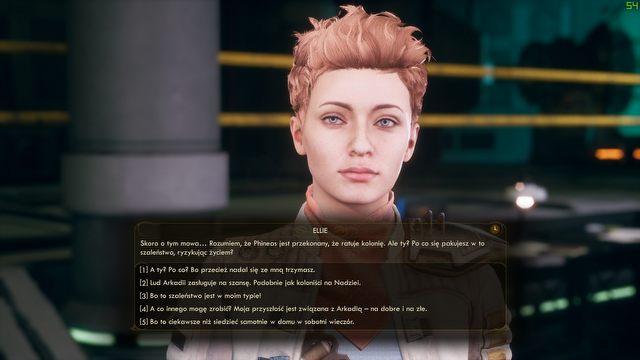
As befits a traditional RPG, the protagonist is a blank page without a voice – the story and personality are created by the player.
So, why the score? That's because The Outer Worlds should be viewed primarily as a classic RPG – and indeed, if we evaluate it from this side, we have to admit it's a piece of really good craftsmanship. If you miss the good old days of "rolplays," in which nameless heroes willingly rushed to save (or destroy) the world for no particular reason, and wasted their time on any trifle quest in the name of collecting experience points along the way – The Outer Worlds will squeeze a tear of nostalgia from your eyes. Unfortunately, for everyone else, those will be mainly tears of sorrow and regret – of the wasted potential.
ABOUT THE AUTHOR
The Outer Worlds devoured about 30 hours so far. I was able to complete the two main paths of the story, and seen both of the core endings (I didn't complete the game twice, only moved to a save from before the critical decision). There's still a dozen or so hours left to max the game out.
I pretty much loved all games from Obsidian so far: Pillars of Eternity II and Tyranny were both a 9/10 for me; the original PoE is not far behind, and so I expected a lot from The Outer Worlds. Unfortunately, this time, the godfathers of the RPG genre made a few bigger mistakes. Their latest work isn't even the best second-rate RPG – whether this game is better than GreedFall or Elex is an open question. Fortunately, 2019 will bring other gems in the RPG genre. Just a week ago, Disco Elysium was released – a phenomenal isometric RPG, which I fell in love with at first sight. Compared to a release like that one, TOW just doesn't look good.
DISCLAIMER
We've received a review copy of the game free of charge from Kool Things – thanks a lot.
The Outer Worlds
The Outer Worlds Review – RPG of the Year? Yeah, of 2012
A year ago, Obsidian heralded The Outer Worlds on the wave of severe criticism of Fallout 76. Today, when Bethesda no longer provides the blanket of a terrible RPG release, things aren't so pretty anymore.
